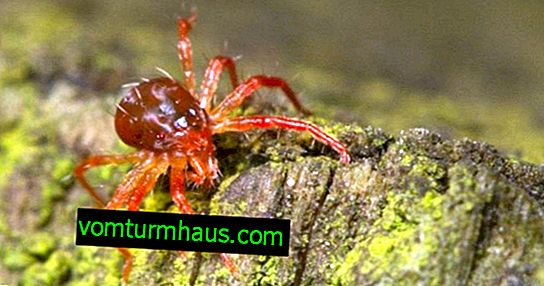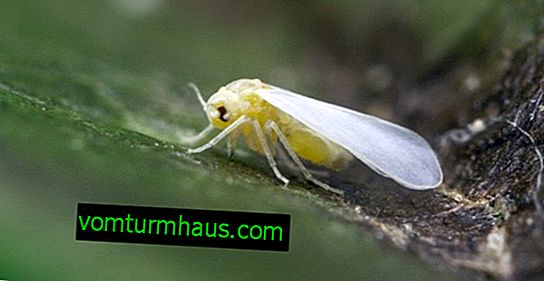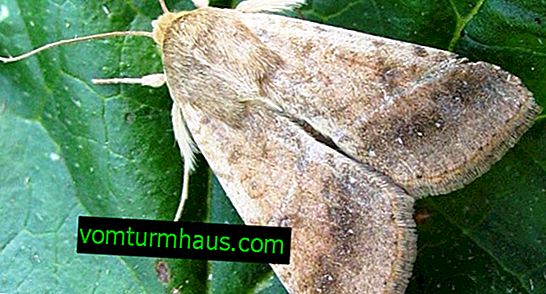Tomato "Grandma's Secret": a description of the variety, especially the cultivation and care
Due to the high yield and excellent taste characteristics, mid-season babushkin secret tomatoes are popular among many gardeners. Judging by the reviews of those who planted this variety of tomatoes, this is a real find for lovers of large and fleshy fruits. What a hybrid is, how it differs from other varieties and what features it characterizes when grown - this will be discussed later.
Create variety
The authorship of Grandma’s secret belongs to the breeders of the Siberian Federal District Vladimir Dederko and Tatyana Postnikova, who, in the process of developing the variety, set themselves the goal of creating large-fruited indeterminate tomatoes. In 2017, the novelty was recorded in the State Register of the Russian Federation. Did you know? For a long time, tomatoes were considered inedible and deadly fruits. In Europe, they could be seen exclusively as ornamental garden plants, and American botany textbooks included a story about how in one restaurant a bribed cook tried to poison George Washington with a tomato dish. In the open ground, such tomatoes are recommended to be grown only in regions where, at the peak of the growing season, a temperature in the range of +20 ... + 25 ° C is possible. In Russia, with the exception of the southern regions, they cultivate this variety of solanaceae in greenhouses, as well as in a covering method.
Detailed description and characteristic
Despite the fact that Babushkin secret appeared on the market of garden products relatively recently, he managed to fall in love with many consumers. Variety is peculiar:
- like other representatives of the indeterminate type, to grow tall - up to 2 meters (usually 1.5–1.8 m), but not a sprawling bush;
- to form on average 8 brushes on each plant, on which no more than 5 ovaries are formed (inhibition in this process is possible at low temperatures of crop cultivation);
- a small amount of dark green foliage on powerful stems and the absence of a fleecy cover on it;
- strong overgrowth of the fibrous root system, which must be taken into account when planning the plot allocated for tomato beds (no more than 2 plants are allowed per square meter);
- average fruit ripening time (from the moment of emergence of shoots it takes about 112–125 days);
- the formation of many lateral sprouts on the stems, which necessitates plant pinching (according to experienced summer residents, the best results were achieved with the formation of a tomato bush of 1-2 stems);
- tomatoes have a rich coral color, are characterized by a round, slightly flattened shape on top with obvious ribbing, inside fleshy, juicy, with a sweetish-sour taste;
- one average fruit weighs approximately 300-600 g (with specific agricultural techniques, some fruits can reach 1000 g);
- the crop is not suitable for long-term storage and does not tolerate transportation; it can be preserved, salted, and also used fresh and for the manufacture of juice;
- high productivity (in greenhouse conditions, with the provision of competent top dressing and regular watering from one bush, you can collect more than 7 kilograms of fruit).

Advantages and disadvantages
- The obvious advantages of Grandmother's Secret can be considered:
- high yielding varieties;
- large-fruited;
- excellent tastes of fruits;
- fruiting duration;
- universality in application.
- The disadvantages are:
- poor harvest keeping quality and its non-transportability;
- the possibility of cracking tomatoes with high humidity;
- a tendency to late blight, fusarium, alternariosis (plants grown on the open ground are especially sick);
- the need for a large area for the successful cultivation of varieties.
Did you know? For the first time, the delicious fruits of tomatoes began to arouse interest among cooks after, in 1822, retired Colonel Robert Gibbon Johnson, having disbelieved in the justice of American courts, decided to poison himself with a bucket of tomatoes right in front of a crowd of thousands gathered at the steps of the Salem House of Justice in New Jersey . Expecting that after such a meal the man would writhe in terrible dying agony, some lost consciousness, others called doctors to stop the daredevil.
Planting and growing tomatoes at home
Regardless of the conditions of further cultivation (greenhouse or open ground), the hybrid is grown in seedlings, which positively affects the quantity and quality of the crop. However, before the fruits ripen, the gardener must successfully overcome a number of tests, which include choosing the right site, processing and sowing seeds, transplanting seedlings and planting them in a permanent place. How to avoid mistakes at each of the upcoming stages, we will consider in more detail.

Optimal conditions for growing
In the greenhouse and in the garden for the Babushkin secret, fertile soils, where cabbage, carrots, and cucumbers previously grew, are ideally suited. It is highly undesirable to plan planting in areas after solanaceous predecessors (potatoes, eggplant). This placement increases the risks of morbidity of the culture, and also, due to the depletion of the substrate, helps to reduce its yield.
Learn more about other varieties of interdeterminant tomatoes:
In regions with a harsh climate and short daylight hours, the best conditions for this type of tomato would be greenhouse conditions, since it is much easier to provide the lack of lighting, as well as maintain the desired temperature regime. The optimal indicators for the hybrid are:
- temperature - + 20 ... + 25 ° C (at lower values of the thermometer problems with the formation of the ovary are possible, as well as pathogenic infections);
- air humidity - 68% (deviation from the norm is fraught with drying of fragile seedlings or the development of fungal diseases);
- lighting with fluorescent lamps for 14-16 hours.
Soil treatment
When horticultural cultivation of varieties is recommended to make a complete replacement of the soil. To do this, use a light mixture of equal parts of garden and sod substrates, as well as humus or compost. Some river sand and peat are mixed into these main components. A similar soil mixture must be prepared in the fall for sowing seeds, which is carried out in late February.

- weak solution of potassium permanganate;
- cool boiling water (temperature not lower than +90 ºС);
- bleach (the substance is poured onto the soil at the rate of 100 g per square meter and sealed with a rake);
- a solution of copper sulfate (prepared in a proportion of 30 g per bucket of hot water);
- gas burner (used only in small areas);
- insecticidal-fungicidal mixture (Intervir and Oksikhom are recommended in the ratio 1: 2, the obtained powder mixture is enough to process 15–20 square meters).
Important! If in the greenhouse the air temperature has not warmed up to +10 ºС, then it is recommended to disinfect walls and ceilings with an aqueous solution of laundry soap. And when the thermometer rises higher, mold and fungi from the inner surfaces of the frame should be removed with Fitosporin. Similar procedures are required to be done with working equipment, drawers, racks.
Planting Material Processing
Experienced gardeners plan to sow Grandmother's secret 60–65 days before the alleged transplanting of seedlings into open beds, so closer to the end of February, you need to prepare the planting material. To this end, it is recommended to soak tomato grains for several hours in a solution of a growth stimulant. Effective are Emistim, Ekosil, Kornevin, Acrobat MC.

Sowing technology
From the second decade of February, you can start preparing for sowing. Grains are preferably deepened into the substrate by one and a half centimeters. To do this, the soil prepared in a box is initially moistened strongly with warm water, and then it is compacted with palms. Seeds are laid out at a distance of 3 cm from each other and sprinkled with fresh soil on top. To get rid of the formed air voids, the contents of the container are rammed. After the manipulations are done, the mini-bed is repeatedly watered and covered with plastic wrap or glass to achieve a greenhouse effect.
Important! Excess moisture for tomato seedlings is fraught with oxygen deficiency, acidification of the soil and the death of the root system. In addition, excessive watering contributes to the appearance of Drosophila, which feed on putrefactive decomposition .
The emergence of early shoots will be accompanied by heat and twilight. However, after a week, the sprouted sprouts will need a full 16-hour lighting for full development, so take care of additional lighting in advance. Most modern vegetable growers prefer to plant seedlings in peat tablets, which are available in specialized garden stores. Their use greatly facilitates the care of seedlings, and also eliminates the need for subsequent transplantation of grown sprouts.

Preparing for transplanting seedlings
The key to a good harvest is timely and competent care for the grown tomato stems, as well as the correct transplanting of seedlings to a permanent place. Even small mistakes at each stage threaten to reduce fruiting and morbidity of the culture. It is important not to miss the picking period, because delaying this procedure will result in severe damage to the overgrown root system and inhibition of the formation of the ovary.
Important! Under low temperature cultivation conditions, the tomato grows smaller and leaves turn yellow. Similar symptoms are observed with a lack of nitrogen.
Before planting tomato seedlings, experienced housewives advise abundantly watering the bed and wait until moisture allows the sprouts to easily pull out from the ground. Plants are transplanted into separate pots, the size of which must correspond to their roots. It is advisable to remove the culture from the box along with an earthen lump. This will allow the vegetable to take root more quickly in the new conditions.

Planting seedlings in a permanent place
Like any other tomato, the secret of Babushkin's secret requires good heat and moisture for good yield. Consequently, a full-fledged vegetation of the culture is possible in a well-fertilized, spacious and lighted area. Ideally, no more than 2 bushes should be placed on each square meter of the allotted area.
Find out why the leaves on the tomatoes turn yellow.
When choosing a tomato bed, it is important to pay attention not only to the soil composition and sufficient illumination, but also to its predecessors. In order not to expose plants to the risk of infection with late blight, root, fruit rot and other diseases, it is better to give preference to areas with clean, soft and enriched land, on which last year they grew:
- legumes;
- onion;
- garlic;
- cucumbers
- all kinds of cabbage.
Ignoring the annual seed changes and cultivation of solanaceae on the same beds will lead to soil oxidation, which will contribute to the development of fungal infection. In such situations, to neutralize the garden, it is recommended that quick lime powder be added in a proportion of 100 g per 1 sq. Km. m

For this purpose, a soil mixture of:
- turf (1 h.);
- peat (1 hour);
- humus (1 hour);
- wood ash (1/3 h.);
- rotted sawdust (1/2 hour);
- superphosphate (150 g);
- potassium sulfate (65 g);
- urea (65 g).
It is advisable to plan a tomato seedling transplantation in open ground during the period of complete exclusion of spring frosts, when the daytime temperature stably fixes at +22 ° С, and nighttime - +17 ° С. Usually we are talking about 45-50-day-old sprouts. For the sun-loving Grandmother's secret, the classic landing scheme is acceptable, providing for half-meter row spacing and a similar distance between neighboring bushes.
Did you know? Although our ancient ancestors considered tomatoes deadly poisonous, today these mouth-watering vegetables hold first place in the ranking of world production. During the year, people collect about 60 million tons of these fruits on all continents.
Also, another technology is acceptable for this hybrid, the essence of which is in double rows with staggered placement of plants and wide paths between them. In this case, seedlings are planted on a strip 50 cm wide, indenting 80 cm. According to reviews of many vegetable growers, it can be concluded that this technology is effective due to the adequate ventilation of high stems, good lighting and the ability to irrigate the hose without preventive spraying of plants or preventive spraying of plants.

Features of tomato care
The tomato variety Babushkin's secret is not demanding to care for and bears fruit well with the elementary observance of the rules of agricultural technology. To ensure full vegetation, the plant needs: space, moderate moisture, timely top dressing, sufficient light, soft and loose soil.
Fertilizers and fertilizers
To get a good crop, the grower needs to regularly fertilize the soil. It is advisable to carry out the first feeding already in 7-10 days after transplanting seedlings, the second - in 2 weeks. It is important to monitor the development of culture. With a lag in growth and weak branch growth, a third top dressing is recommended. It is carried out, having sustained a two-week pause after the second.
Important! In the spring, when daylight hours last no more than 13 hours, take care of additional lighting in the greenhouse. Otherwise, there is a high probability of inhibition in the growth of tomato bushes. Then the first inflorescences will appear not on the 7-8th leaf (as it should be), but on the 13th.
As fertilizer on tomato beds use a solution of chicken droppings (in the ratio of 1:15) or mullein (1: 8). However, do not overdo it: generous top dressing is fraught with poor harvest and lush foliage.

Watering
Excessive moisture threatens the development of late blight on tomatoes and overgrowth of bushes, so it is important to monitor the amount of moisture in the garden. Dry soil is not permissible, as is its bogging. To avoid empty emasculation of plant resources and direct them to the formation of fruits, the gardener should water the tomatoes no more than 2-3 times a week. It is better to carry out the procedure in the morning so that the sun's rays do not burn wet leaves and stems. Note that not all water is suitable for irrigating a tomato bed. Ideal to use warm and settled.
Read more about how to properly water tomatoes in a greenhouse.
Stepson
It happens that the greenhouse seedlings of tall tomatoes are greatly extended, forming thread-like stems incapable of bearing fruit. To prevent this from happening, on the sprouts you need to remove the lower pair of foliage. This will stop the development of the bush up and will contribute to the buildup of its lateral branches, as well as the root system. Grandma’s secret, like other indeterminate varieties, is prone to strong branching, so buds of new sprouts are noticeable in the leaf sinuses of the stems of the hybrid.

Important! In the southern regions, where the cultivation of indeterminate tomatoes in the open ground is practiced, it is advisable to pinch the top shoot of the central trunks in the early stages of bush formation. And in conditions of protracted damp weather, the removal of all unformed flower brushes is required.
Специалисты советуют формировать куст гибрида в 2 главных стебля. Кроме того, для паслёновых культур этого типа имеет значение ликвидация верхушек ростков. Делается это для того, чтобы ограничить рост растения, направить его силы на укрепление корней и формирование плодов. Место подобной прищипки определяется на уровне 3–4 соцветий.
Bush tying
Помимо пасынкования, важно провести своевременную подвязку куста к опоре, ведь под весом тяжёлых плодов хрупкие ростки могут сломаться. К тому же застой воздуха в нижней зоне кустов может стать причиной развития грибковых заболеваний. Опытные овощеводы советуют сразу же после высадки рассады установить на грядке шесты из любого материала, чтобы в меру роста растений подвязывать их.
Для этих целей рекомендуется использовать широкие тканевые ленты либо пластиковые зажимы, поскольку тонкий проволочный, нитевой и верёвочный материал может повредить культуру. Некоторые огородники делятся опытом подвязывания томатов к размещённым в верхней зоне теплицы трубам либо к специальной шпалере. Отметим, что последний вариант заслуживает внимания лишь в случае необходимости развития боковых побегов.
Видео: подвязка томатов
Soil cultivation and weeding
Борьба с сорняками и регулярное рыхление грунта ― острая необходимость успешного плодоношения томатов, а не бессмысленные требования эстетов. Первую прополку тяпкой нужно осуществить уже через 2 дня после пересадки рассады на постоянное место. При этом важно проявить максимальную осторожность, чтобы не повредить поверхностные корневые отростки. В дальнейшем процедуру повторяют, исходя из состояния почвы. Нельзя допускать образования в лунках засохших сухих корок после полива.
Important! Чтобы недозревшие помидоры не растрескивались, нужно в жаркую погоду обильно полить грядку и накрыть её укрывным материалом .
Взрыхлив землю, вы не только улучшите аэрацию корневой системы, а и удалите сорные растения, которые являются благоприятной средой для вредителей и главными конкурентами в питании. Спустя 2 недели после пересадки, рассаду нужно окучить.

Diseases and Pests
Бабушкин секрет, как и другие сорта томатов, проявляет повышенную чувствительность к патогенной среде микроорганизмов.
При нарушениях правил агротехники растение может болеть:
- фитофторозом;
- мозаикой;
- гнилостными инфекциями;
- альтернариозом;
- anthracnosis;
- бактериальной и бурой пятнистостью;
- раком.
Вам также будет интересно узнать как лечить фузариоз и кладоспориоз томатов.
Чтобы избежать заражения, опытные огородники советуют соблюдать требования культуры и постоянно следить за её развитием.
Если что-то пойдёт не так, исправить ситуацию можно с помощью сильнодействующих фунгицидов:
- «Максим»;
- "Prestige";
- «Барьер»;
- «Заслон»;
- "Fundazole";
- «Хом».
Кроме того, на томатной грядке частыми гостями могут быть:
- колорадские жуки;

- spider mites;

- галловые нематоды;
- caterpillars

- whiteflies;

- scoops.

Избавиться от этих вредителей помогут инсектицидные препараты:
- "Aktara";
- «Би 58» – Новый.
Did you know? Рекордно большой помидор удалось вырастить висконсинскому фермеру (Соединённые Штаты Америки). Плод по своим размерам напоминал средний арбуз и весил почти 3 килограмма.
Harvesting and storage of crops
В меру созревания плодов их необходимо снимать со стеблей, чтобы не допускать перезревания и растрескивания. Данная продукция не пригодна для длительного хранения и перевозок, поэтому её лучше использовать для салатов, а также для консервирования. Из Бабушкиного секрета получается отменный томатный сок, аджика, домашний кетчуп и соления. Томаты сорта Бабушкин секрет вовсе не требуют дополнительных знаний и умений. За элементарный уход, который необходим любому растению, они сполна отблагодарят высококачественным обильным урожаем.








